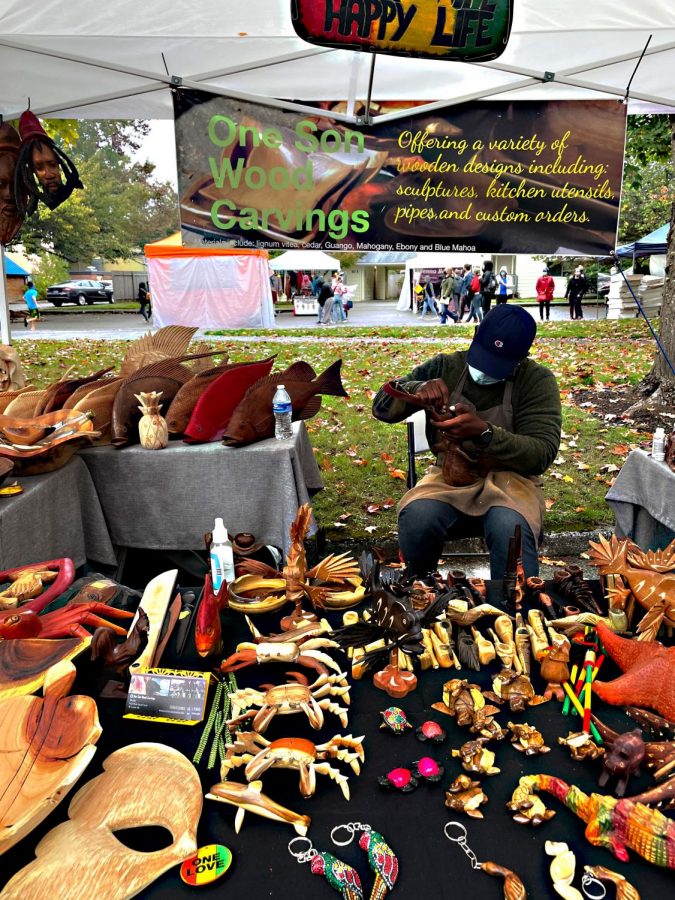Salmon Days: Then and Now
October 7, 2021
Salmon Days has once again come to Issaquah and ran from Oct. 2 to Oct. 3, 10 a.m. to 6 p.m. and there is a lot to know about it. The annual event has a rich history that is rooted in a blend of tourism and salmon, with a drastic turning point that allowed the holiday to turn into the festival that easily breaks 100,000 attendees every year. There were lots of changes and digital alternatives at the holiday this year that aided in navigating the event. The IHS consensus of the holiday will help in learning the relationship a lot of people have with the holiday, and people’s thoughts on its continuation. Also, the salmon situation in Washington begs to have more people supporting it.
The first Salmon Days were held in 1970 by the Issaquah Chamber of Commerce to replace the rapidly aging Labor-Day celebration that had begun to lose the interest of citizens. Issaquah residents wanted something to breathe a new vitality into the town, something that would put the city on the map and differentiate it from the nearby towns of Snoqualmie, Bellevue, and Renton. The chamber thought of the idea of Salmon Days as it would celebrate the incoming Salmon that pour through the town while attracting nearby tourists from other towns as well. The first few Salmon Days were pretty small but that all changed in 1980 when the event officially became a Seafair sanctioned event. Salmon Days was registered as an official northwest holiday and would be granted funding for the festival via the organization Seafair, a non-profit that provides backing to events that showcase our Northwest culture. This expanded the scope of what Salmon Days could be tenfold and increased tourism for the event drastically. It eventually paved the way for Salmon Days to become the holiday we all know today.
Salmon Days is an annual tradition where the town of Issaquah gathers for festivities in the Olde Town district. As fun as Salmon Days is, the root of the holiday is set for the conservation and awareness of the declining salmon population. According to the 2020 State of Salmon in Watersheds Executive Summary report, there are 14 endangered species of salmon in Washington alone. As the Washington State Recreation and Conservation Office puts it, “Washingtonians stand at a fork in the road with a clear choice: Continue with current practices and gradually lose salmon, orcas, and a way of life that has sustained the pacific northwest for eons. Or, change course and put Washington on a path to recovery that recognizes salmon and other natural resources as vital to the state’s economy, growth, and prosperity.” The loss of salmon will impact the state in momentous ways which will have ripple effects far beyond a forced rebranding of Salmon Days. Junior Aryan Puthran says the loss of salmon “would impact the culture a lot since we see salmon everywhere we go.” Salmon can be seen all over Washington, and it is hard to imagine the devastating effect their loss would reap. The newest causes of this loss include habitat degradation, fish passage barriers, harvest, hydropower, and climate change. These may seem like big issues that would be impossible to tackle individually, but just the knowledge of this endangerment is enough to make an impact. Neither Freshman Reese Treadway, Sophomore Destry Lewis, Puthran, nor Senior Skylar Kang had any knowledge about the amount of trouble the salmon are in, but now that they are aware they all want to help the salmon in any way they can. Anyone can help by picking up that plastic bag in the river, walking or biking instead of driving, and using the power of your voice to spread the word. Everything helps in the fight to help our fish friends prevail.
The changes present at the recent Salmon Days event to maintain COVID-19 protocols included the salmon hatchery only allowing a limited population in at a time. If you wish to see the salmon in the hatchery thoroughly there are options to book a guided tour for $5 per ticket for following weekends through the Friends of the Issaquah Salmon Hatchery who describe the tours as “an opportunity to learn about and see the salmon this season.” Instead of live music the bands at Kaleidoscope School of Music played via a live stream that was projected onto the main stage. Everybody attending the event was required to wear a mask at all times unless actively eating. As freshman Reese Treadway states, “I would feel safe going to Salmon Days if everyone was wearing masks.” This mandate was expected to be beneficial in getting more people to feel safe attending the event. The booths selling, showcasing and trading goods were further distanced than years in the past. Directional signs enforced that everyone stay on the right side of the street making the flow of the festival more fluid than Salmon Days has been historically, where it would be hard to navigate the bustling streets. Sanitizing stations were also spread throughout the festival providing opportunities for cleaning your hands if at any point you felt the need to. Even with these changes ramping up the safety of the event tenfold there were still more than 300 artisanal booths ready to sell you whatever would catch your eye and around 40 food booths were present in the “foods from around the world” food court. Some events were cancelled. These included the 5k run, Kiwanis salmon BBQ, carnival, and the Salmon Days Parade. Despite these changes Salmon Days turned out to be plenty of fun and free of the worry of COVID-19.
With the festival recently coming to the town, it would be useful to learn the overall IHS consensus of the holiday. Lewis stated, “It was the place to be for however long it was.” However, Kang who’s never been to the holiday before said, “I just didn’t have interest in it, so I just never went.” It even seems that some students have forgotten about the existence of Salmon Days altogether. Puthran states “I haven’t even heard the words Salmon Days in years.” The event however in recent memory has seen an unprecedented population, with Brenda DeVore, the events and community manager at the Issaquah Chamber of Commerce, stating, “An average of 150,000 people attend Salmon Days each year.” Despite these numbers, the event staff sought to create a symbiotic relationship at the festival that intertwines the fun of the holiday with the betterment of the salmon. Let us hope for a good Salmon Days this year that hits these marks well.
Another Salmon Days is in the books and it looks like it went pretty well. No COVID-19 breakouts occurred and everything ran rather smoothly. The festival contained a good amount of content and the famous food court still contained a super diverse number of cultures to pick from when feasting. Despite feeling a little lighter this year than past celebrations of the salmon due to some cancellations the holiday still managed to capture the hearts of Issaquah’s citizens and was overall a success.


